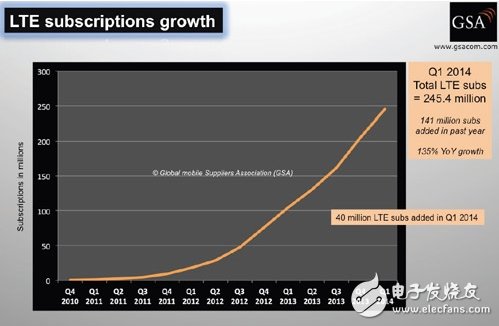According to the latest GSA report, 318 operators in 111 countries have launched LTE services. From the beginning of 2014 to the present, in less than one year, 51 LTE networks have been commercialized worldwide, and it is expected that by the end of the year, LTE commercial networks will reach 350. At the same time, the signing of LTE roaming agreements is rapidly expanding.
The most popular three bands
From the adopted frequency band, the most widely used spectrum for LTE applications is 1800MHz, which is 3GPP band 3. The LTE network of 144 operators in 70 countries uses this frequency band, accounting for more than 45%. Of course, this frequency band is also the terminal. The most widely supported products, more than 40% of the terminal equipment supports 1800MHz. Second only to 1800MHz is the 2.6GHz band, which is band 7, which accounts for 26.4% of the global commercial LTE services.
The adoption rate of 800 MHz, the band 20 band, ranks third. It is also the most popular LTE band below the 1 GHz band, which is used in 55 commercial networks in 33 countries around the world. Moreover, 800 MHz has a mature ecosystem in terms of terminal equipment, and 467 models of equipment supporting this band are available worldwide.
Alan Hadden, president of GSA, said that the deployment of LTE networks below the 1 GHz band is mostly in the 700 MHz and 800 MHz bands, mainly for wide-area LTE coverage in rural areas. In many cases, operators use these two bands for indoor mobility. Broadband improves performance.
China into TD-LTE catalyst
Up to now, LTE networks of 39 operators in 26 countries around the world use TDD technology, which means that one-eighth of operators choose TD-LTE. Among them, 26 operators launched pure TD-LTE networks, and the other 13 deployed networks that support both TD-LTE and LTE FDD. The two branches of the LTE standard are technically the same, and the two branches share the benefits of economies of scale and ecological chain growth.
The terminal ecosystem of TD-LTE, especially band 38 (2.6 GHz) and 40 (2.3 GHz), has the same support, accounting for 68% of the entire TD-LTE ecosystem.
China's LTE deployment is the most important catalyst for growth. As of July 14, GSA statistics show that 168 terminal manufacturers worldwide have launched 1889 LTE ​​terminals. Last year alone, 941 models of LTE products were listed, and most terminals support both TDD and FDD. Among them, 530 models support TD-LTE, 330 more than last year.
According to the communication and confirmation of GSA, it is confirmed that more and more terminal manufacturers will introduce more new products at different price points. Currently,
Among LTE terminal products, smartphones account for the largest proportion, and 835 smart phones support LTE, accounting for 44% of all LTE products. MiFi and tablets supporting LTE signals are also growing. Up to now, 175 tablets have supported LTE, accounting for 9.2% of all LTE products.
LTE evolution technology flourishes
At present, 66 operators in 35 countries around the world are investing in VoLTE, some are testing, and some are starting to deploy, 10 of which are in Asia, such as Hong Kong, Japan, Singapore, and South Korea. Carriers in the United States have begun commercial VoLTE-based HD voice services. According to GSA statistics, 92 smartphones worldwide support VoLTE.
69 operators are deploying LTE-Advanced networks, and 16 operators have adopted carrier aggregation technology. Four of them support 300 Mbps Category 6 terminal equipment, and LTE networks in 36 countries support a downlink peak of 150 Mbps.
At present, the LTE network of six operators around the world uses the APT700 frequency band, and all of them are LTE FDD, that is, the national unified 3GPP band 28. The APT700 is an important frequency band for deploying LTE. Currently, 11 terminal manufacturers have launched 33 APT700 terminals, including smartphones, tablets, CPE and MiFi hotspots.
More and more operators are starting to study LTE Broadcast and eMBMS technologies, which can transmit multimedia content, especially audio and video, in a one-to-many manner. Several operators have already announced the testing process.
GSA expects that LTE users are rapidly moving toward the 300 million mark. As of the end of March this year, the number of LTE users worldwide is 245.4 million.

LTE user growth trend: 40 million LTE users will be added in the first quarter of 2014 alone
This is flex LED neon sign, soft silicon tubes with flexible LED strip inside tubes look like vintage glass neon sign. Flex LED neon sign is safe, non-frangible. It's better choice for large text and logo. Glass neon sign is frangible, but is more flexible and better bending for small text logo. If you are looking for glass neon sing, please visit our store or contact us.
The flex LED neon sign is recommended for wedding, makeup, tattoo, bar, coffee, business store & home decoration etc. It's hand crafted artist. Show your characters by custom personalize neon sign. Contact and discuss with us about your design or idea. Make your dreams come true!
Custom neon sign, unique neon signs, personalized neon signs
Shenzhen Oleda Technology Co.,Ltd , https://www.baiyangsign.com